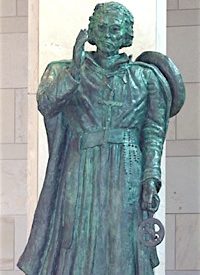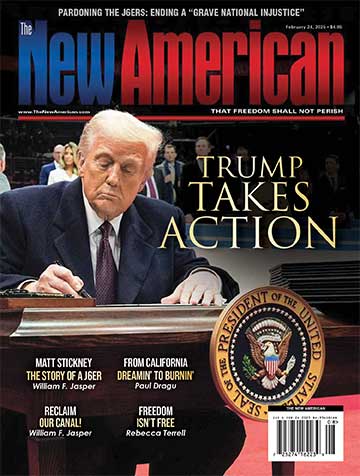
Three hundred sixty six years ago today a man was born who became one of history's foremost explorers of the southwestern United States and northern Mexico. His name was Eusebio Francisco Kino, and a statue honoring his contributions to what became the state of Arizona now graces National Statuary Hall in the U.S. Capitol Building (picture at left).
This little-known American hero began his life in the small town of Segno, Italy. He was educated in Austria, joined the Society of Jesus in 1665, and departed as a missionary for Mexico in 1678. For the next 33 years until his death in 1711, Father Kino dedicated his life to developing civilization in the uncharted wilderness of the new world.
Father Kino's work centered on the area then known as Pimeria Alta, which is now southern Arizona and northern Sonora, Mexico. He became a beloved missionary to the Piman Indians, fighting for their land rights and against forced labor in the silver mines of northern Mexico, despite frequent opposition from the Spanish government. Along with numerous missions Father Kino founded, he built 19 ranches and taught the natives the arts of agriculture and animal husbandry, supplying the new settlements with food and livelihood. Some of his original imported fruit trees survive to this day and are cultivated by the Kino Heritage Fruit Tree Project. The popular Mexican wine "Padre Kino" recalls his introduction of the Zinfandel grape to the area.
But that is only a small part of his résumé. He also served as an explorer, cartographer, astronomer, and historian. He was the first to chart the region and is credited with discovering the sources of many rivers there, including the Rio Grande. In 1705, he published the first map of the Pimeria Alta region. It was he who proved the Baja Peninsula was not an island, as was then supposed, and paved the way for future development there. Natives knew him as the priest who conquered the "Devil's Highway," a waterless wasteland between Sonoita, Mexico and Arizona's Gila River, considered largely impassable until then.
His work in astronomy led to the publication in 1711 of Exposicion Astronomica de el Cometa, an account of the Great Comet of 1680 also known as Kirch's Comet or Newton's Comet. It was discovered by Gottfried Kirch in 1680, but Kino was able to chart the comet's course, beginning his observations in Europe and concluding them in Mexico.
For these and his many more accomplishments Father Kino accepted no personal credit. In the opening pages of one of his books, Favores Celestiales, detailing his work and explorations Father writes "that these new conquests and new conversions are to such an extent due to the celestial favors of Our Lord that they cannot be attributed to human forces."
Together this priest-explorer traveled over more than 50,000 square miles in more than 40 expeditions, and his work opened the door to further settlement of California by Jesuit missionaries in the 18th century. After his death, Father Kino's missions were transferred to the Franciscan order, and many are still in operation today.
He died on March 15, 1711, in Magdalena, Mexico, which was later renamed Magdalena de Kino in his honor. Visitors can pay their respects at his crypt and memorial in that city. Earlier this year, the Vatican issued a postage stamp commemorating the 300th anniversary of his death. Today, the Kino Heritage Society works to promote this humble priest's legacy through "educational presentations, workshops, lectures and publications on Padre Kino's contributions to the peoples of the Pimeria Alta." Chaired by the Bishop of the Diocese of Tucson, the Society supports Father Kino's cause of canonization (recognition of sainthood).




